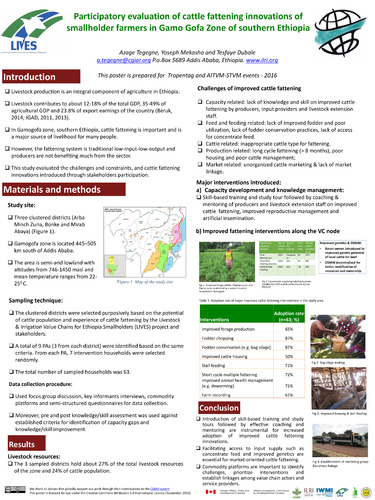Participatory evaluation of cattle fattening innovations of smallholder farmers in Gamogofa zone of southern Ethiopia
Abstract
The study was conducted in Gamogofa zone, southern Ethiopia, located 445-505 km south of Addis Ababa. The area is semi-arid lowland with altitudes ranging from 746 to 1450 m asl and mean temperature ranges from 22 to 25 °C. The dominant farming system is mixed crop-livestock. Cattle, goats and poultry are the major livestock species, while maize, sorghum, teff, banana and mango are the major crops. Cattle fattening is an important undertaking and source of livelihoods. However, the fattening system is traditional low-input-low-output and producers are not benefiting much from the sector. This study evaluated the challenges and constraints, and cattle fattening innovations introduced through the participation of stakeholders in the study area. The study used focus group discussion, key informants interview, livestock commodity platforms and questionnaires for data collection. The major challenges and constraints identified are; a) feed and feeding related - lack of improved fodder and poor utilisation, lack of fodder conservation practices, poor natural grazing lands management and energy loss due to long distance grazing; lack of access for concentrate feed; b) cattle related - inappropriate cattle type for fattening; c) production related - long cycle fattening (> 8 months), poor housing and poor cattle management; d) market related - unorganised cattle marking, dominance of local markets with brokers which makes producers price takers, lack of market linkage; e) capacity related - lack of knowledge and skill on improved cattle fattening by producers, input providers and livestock extension staff. The following interventions were introduced: a) capacity related, which includes skill based training and coaching & mentoring of producers and livestock extension staff on improved cattle fattening, improved reproductive management and artificial insemination; b) fattening innovations which includes stall feeding instead of grazing, short cycle (3-4 months) multiple fattening per annum, improved on farm fodder production, improved fodder utilisation through chopping, fodder conservation through bag silage making & proper harvesting and storage of crop residues, initiation of commercial concentrate feed supplying business and use of concentrate supplementation, better animal selection from the market and deworming before fattening, establishment of fattened cattle marketing groups, and marketing linkage with buyers.

